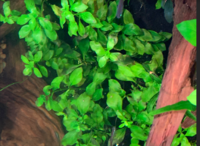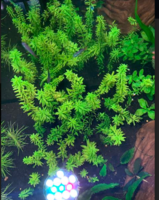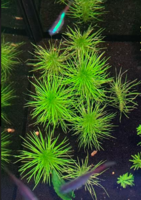Hi everyone,
UKAPS has been a great source for me for help with this hobby, as I absolutely love it - so thank you.
I have a journal going and have made some posts here and there, but my biggest issue that I am running into is lack of experience. I keep thinking that I need to let it grow out - the problem is that I do not have the experience of the "grow out" process, so - in the spirit of proactivity - I do not know if what I am seeing will be "ok" - if I knew that what I am seeing is "ok", then I wouldn't be posting.
So, I planted originally and had to replant 1 week ago (my plants were choking each other out and I had to fix the flow distribution to those lower leaves; I also had lots of lower plant leaf die off):
What caused it?
1) Ferts
2) CO2
3) Flow distribution for the latter two
4) Light?
Right before my replant, I ran into an issue with a potential magnesium/iron deficiency where @Witcher, @dw1305, and @Zeus. helped me. Since then, I rearranged my flow (which I have a spray bar coming within the next 2 days which will improve this I am certain), moved my pH probe to check pH drop all over the tank, placed drop checker both on top and by the bottom of tank, and have started dosing EI: Micro 1 day, Macro the other day both before lights on - measurements via https://rotalabutterfly.com/ .
DC: DC is green on top and yellow on bottom - kind of bizarre? - going to change the fluids tonight (it has been consistent all week).
pH: pH drop goes to 5.9/6.0 at lights on from 7.3ish (at complete off gas). If it hits 5.8 fish gasp.
Ferts: The melt you are seeing on the Ludwigia below has me thinking this is a phosphate or nitrogen deficiency - but it can't be (unless I have some uptake blocking - but I checked Mulders chart) - or a delivery of nutrients via flow.
Day 1: after planting, I had no die off so I thought this was a good change
Day 2: I had some perfectly healthy leaves fall off -- always lower leaves
Day 7: Now I am seeing the photo below.

In the image above, I circled the dying leaves in red, and I circled the new growths in blue. The stunted growth either indicated to me nitrogen or CO2 - or could it just be slower growth? I would say that some of this may have been from before the replant (I simply moved this plant to the right a bit -- There is LESS flow here).
I will say that there is also root tabs in the tropica powder substrate below.
The picture below is of the Rotala and I took it from the top view intentionally - so none of the perhaps earlier deficiency can be mixed up with the new growth. No melt from these guys, but the growth looks small/stunted? Or is just slow?

Again, I circled some new growth with blue --> I am quite happy with the color and shape, but they are just small - and I am getting worked up that they are "stunted" -- or will they eventually get bigger and it is just that they are growing slowly.
Now, I moved the Pogo below from the new place of the ludwigia and in this "nice place" where the flow drops that enriched CO2 right down onto it.

I did not highlight this one as you can clearly see what is dieing and what is not -- First few days not much die off, then suddenly, I had a bunch of leaves - only lower leaves - fall off. The dying guys have new growth but it is small/slow/the bottom ones are all dying.
For what it is worth, my Bucephalandra is growing well and having those micro bubbles inside each leaf; my java fern has little pearls under it; my anubias seems ok too. You can see these epi's all on the wood on the right side of the tank.

The S.repens above, has "maybe" noticeably grown but also hasn't melted - I think this is important to note - it has been in since the planting about 2 weeks ago.
I read so much about light rarely being deficient that I started my lighting really low. In terms of photoperiod and co2 timing, I attempted to do this:

but my plants do not photosynthesize hard enough to force that pH back up like that. My max intensity is 40% on my reds, 15% greens, 10% blues, 10% warm white, 10% cool white AI Prime HD Freshwater (https://www.aquaillumination.com/products/prime-freshwater) --> I have 2 of these lights over top.
My tank is 24 inches deep (65 gallon, 36 inches long, 18 inches wide). Seeing as how perfectly healthy growth fell off my Ludwigia, the erectus has super thin leaves, the growth has been slow, and my epiphytes near the top are pearling, is it possible that I just do not have enough light to penetrate deeper into the tank?
Note: I have no algae (any GSA you see on the epiphytes is extremely old from old tanks and I should trim those leaves, the buce when I bought it had some BBA on its edge leaves and it has actually retracted in the tank so far)-- after the replant, I reduced my lights in hopes of preventing the outbreak as I may have stirred up some ammonia etc and junk in the water column, despite changing water that day.
I know that each plant has a minimum amount of light required to grow, but it is continually quoted that this minimum everyone basically has so quit worrying about light.
I think a good question and perhaps for another post I have would be what is the difference between a light deficiency and a co2 deficiency. I mean that is all we got if we are dosing in ideal ratios so as not to mess with uptakes and in aroundish EI amounts.
All this to say, I wrote far more than intended but I wanted to give all of the details, and I greatly appreciate anyone who does read/skim through it - so thank you in advance.
I suppose my question is, is there an issue here? Should I increase my light? Or should I just wait?
Cheers,
Josh
UKAPS has been a great source for me for help with this hobby, as I absolutely love it - so thank you.
I have a journal going and have made some posts here and there, but my biggest issue that I am running into is lack of experience. I keep thinking that I need to let it grow out - the problem is that I do not have the experience of the "grow out" process, so - in the spirit of proactivity - I do not know if what I am seeing will be "ok" - if I knew that what I am seeing is "ok", then I wouldn't be posting.
So, I planted originally and had to replant 1 week ago (my plants were choking each other out and I had to fix the flow distribution to those lower leaves; I also had lots of lower plant leaf die off):
What caused it?
1) Ferts
2) CO2
3) Flow distribution for the latter two
4) Light?
Right before my replant, I ran into an issue with a potential magnesium/iron deficiency where @Witcher, @dw1305, and @Zeus. helped me. Since then, I rearranged my flow (which I have a spray bar coming within the next 2 days which will improve this I am certain), moved my pH probe to check pH drop all over the tank, placed drop checker both on top and by the bottom of tank, and have started dosing EI: Micro 1 day, Macro the other day both before lights on - measurements via https://rotalabutterfly.com/ .
DC: DC is green on top and yellow on bottom - kind of bizarre? - going to change the fluids tonight (it has been consistent all week).
pH: pH drop goes to 5.9/6.0 at lights on from 7.3ish (at complete off gas). If it hits 5.8 fish gasp.
Ferts: The melt you are seeing on the Ludwigia below has me thinking this is a phosphate or nitrogen deficiency - but it can't be (unless I have some uptake blocking - but I checked Mulders chart) - or a delivery of nutrients via flow.
Day 1: after planting, I had no die off so I thought this was a good change
Day 2: I had some perfectly healthy leaves fall off -- always lower leaves
Day 7: Now I am seeing the photo below.
In the image above, I circled the dying leaves in red, and I circled the new growths in blue. The stunted growth either indicated to me nitrogen or CO2 - or could it just be slower growth? I would say that some of this may have been from before the replant (I simply moved this plant to the right a bit -- There is LESS flow here).
I will say that there is also root tabs in the tropica powder substrate below.
The picture below is of the Rotala and I took it from the top view intentionally - so none of the perhaps earlier deficiency can be mixed up with the new growth. No melt from these guys, but the growth looks small/stunted? Or is just slow?
Again, I circled some new growth with blue --> I am quite happy with the color and shape, but they are just small - and I am getting worked up that they are "stunted" -- or will they eventually get bigger and it is just that they are growing slowly.
Now, I moved the Pogo below from the new place of the ludwigia and in this "nice place" where the flow drops that enriched CO2 right down onto it.
I did not highlight this one as you can clearly see what is dieing and what is not -- First few days not much die off, then suddenly, I had a bunch of leaves - only lower leaves - fall off. The dying guys have new growth but it is small/slow/the bottom ones are all dying.
For what it is worth, my Bucephalandra is growing well and having those micro bubbles inside each leaf; my java fern has little pearls under it; my anubias seems ok too. You can see these epi's all on the wood on the right side of the tank.
The S.repens above, has "maybe" noticeably grown but also hasn't melted - I think this is important to note - it has been in since the planting about 2 weeks ago.
I read so much about light rarely being deficient that I started my lighting really low. In terms of photoperiod and co2 timing, I attempted to do this:
but my plants do not photosynthesize hard enough to force that pH back up like that. My max intensity is 40% on my reds, 15% greens, 10% blues, 10% warm white, 10% cool white AI Prime HD Freshwater (https://www.aquaillumination.com/products/prime-freshwater) --> I have 2 of these lights over top.
My tank is 24 inches deep (65 gallon, 36 inches long, 18 inches wide). Seeing as how perfectly healthy growth fell off my Ludwigia, the erectus has super thin leaves, the growth has been slow, and my epiphytes near the top are pearling, is it possible that I just do not have enough light to penetrate deeper into the tank?
Note: I have no algae (any GSA you see on the epiphytes is extremely old from old tanks and I should trim those leaves, the buce when I bought it had some BBA on its edge leaves and it has actually retracted in the tank so far)-- after the replant, I reduced my lights in hopes of preventing the outbreak as I may have stirred up some ammonia etc and junk in the water column, despite changing water that day.
I know that each plant has a minimum amount of light required to grow, but it is continually quoted that this minimum everyone basically has so quit worrying about light.
I think a good question and perhaps for another post I have would be what is the difference between a light deficiency and a co2 deficiency. I mean that is all we got if we are dosing in ideal ratios so as not to mess with uptakes and in aroundish EI amounts.
All this to say, I wrote far more than intended but I wanted to give all of the details, and I greatly appreciate anyone who does read/skim through it - so thank you in advance.
I suppose my question is, is there an issue here? Should I increase my light? Or should I just wait?
Cheers,
Josh






 I have great respect for
I have great respect for 